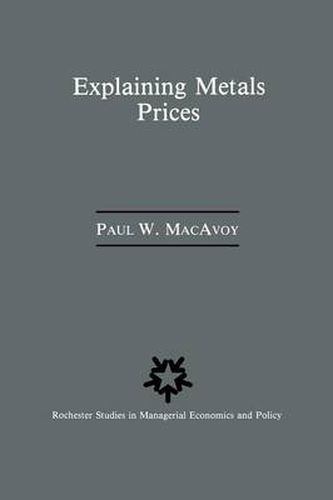Readings Newsletter
Become a Readings Member to make your shopping experience even easier.
Sign in or sign up for free!
You’re not far away from qualifying for FREE standard shipping within Australia
You’ve qualified for FREE standard shipping within Australia
The cart is loading…






This title is printed to order. This book may have been self-published. If so, we cannot guarantee the quality of the content. In the main most books will have gone through the editing process however some may not. We therefore suggest that you be aware of this before ordering this book. If in doubt check either the author or publisher’s details as we are unable to accept any returns unless they are faulty. Please contact us if you have any questions.
Work on this book began in the Spring of 1983, not long after an Amax Corporation annual budget meeting. As a member of the Amax board of directors since 1979, I had been present at such meetings in which the molybdenum price had been forecast to move higher than $7.00 per pound. The actual annual average prices were $9.70 in 1980, $8.50 in 1981, and $4.00 in 1982. The forecast for 1983 called for prices to return to higher levels, but as both dealer and producer prices declined further, my research began in earnest. Initially, the research was to address the question of why the molybdenum price had declined by more than half in a short period. More fundamental, as other metals prices also declined, was an impelling need to know the causes of the abrupt and sustained reduction in metals price levels that year. As prices stayed at low levels, while those of other materials recovered over the 1983-1986 period, the question became that of why metals prices had remained at startlingly low levels for over five years.
$9.00 standard shipping within Australia
FREE standard shipping within Australia for orders over $100.00
Express & International shipping calculated at checkout
This title is printed to order. This book may have been self-published. If so, we cannot guarantee the quality of the content. In the main most books will have gone through the editing process however some may not. We therefore suggest that you be aware of this before ordering this book. If in doubt check either the author or publisher’s details as we are unable to accept any returns unless they are faulty. Please contact us if you have any questions.
Work on this book began in the Spring of 1983, not long after an Amax Corporation annual budget meeting. As a member of the Amax board of directors since 1979, I had been present at such meetings in which the molybdenum price had been forecast to move higher than $7.00 per pound. The actual annual average prices were $9.70 in 1980, $8.50 in 1981, and $4.00 in 1982. The forecast for 1983 called for prices to return to higher levels, but as both dealer and producer prices declined further, my research began in earnest. Initially, the research was to address the question of why the molybdenum price had declined by more than half in a short period. More fundamental, as other metals prices also declined, was an impelling need to know the causes of the abrupt and sustained reduction in metals price levels that year. As prices stayed at low levels, while those of other materials recovered over the 1983-1986 period, the question became that of why metals prices had remained at startlingly low levels for over five years.